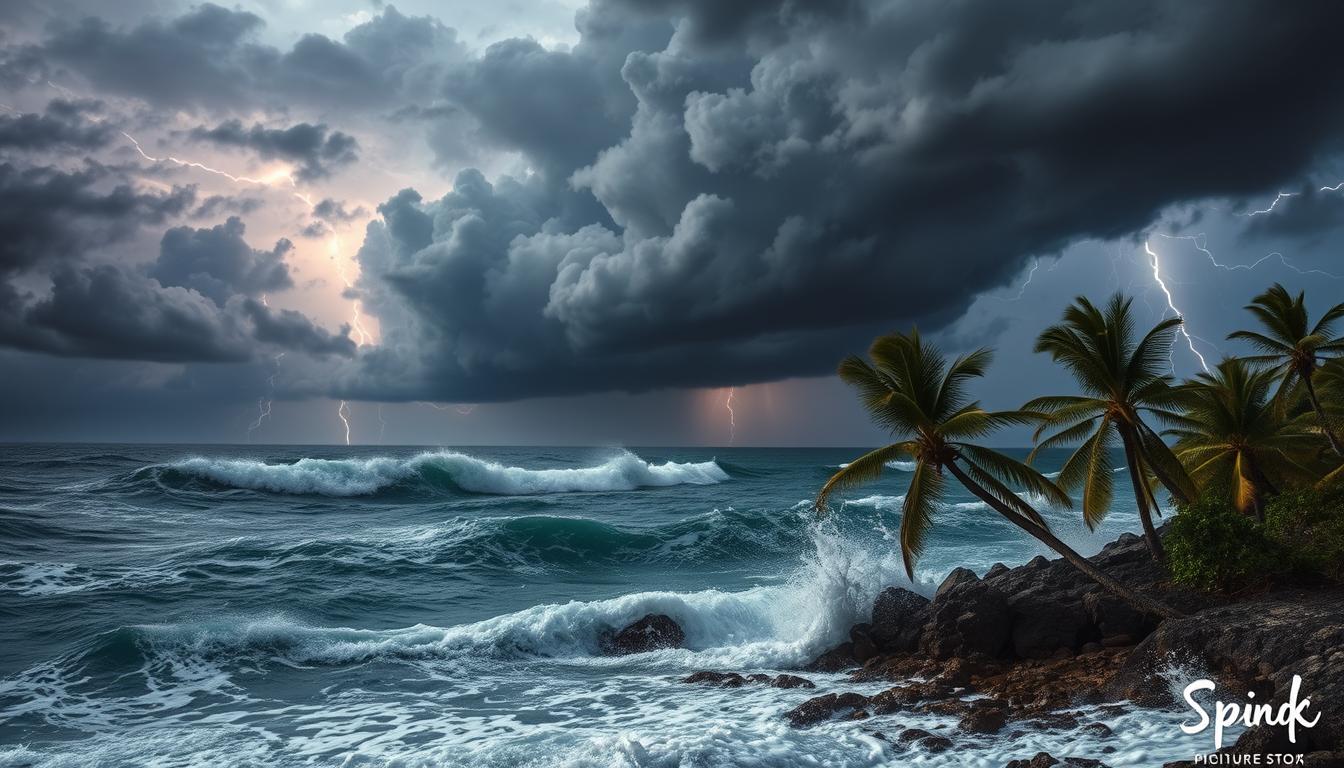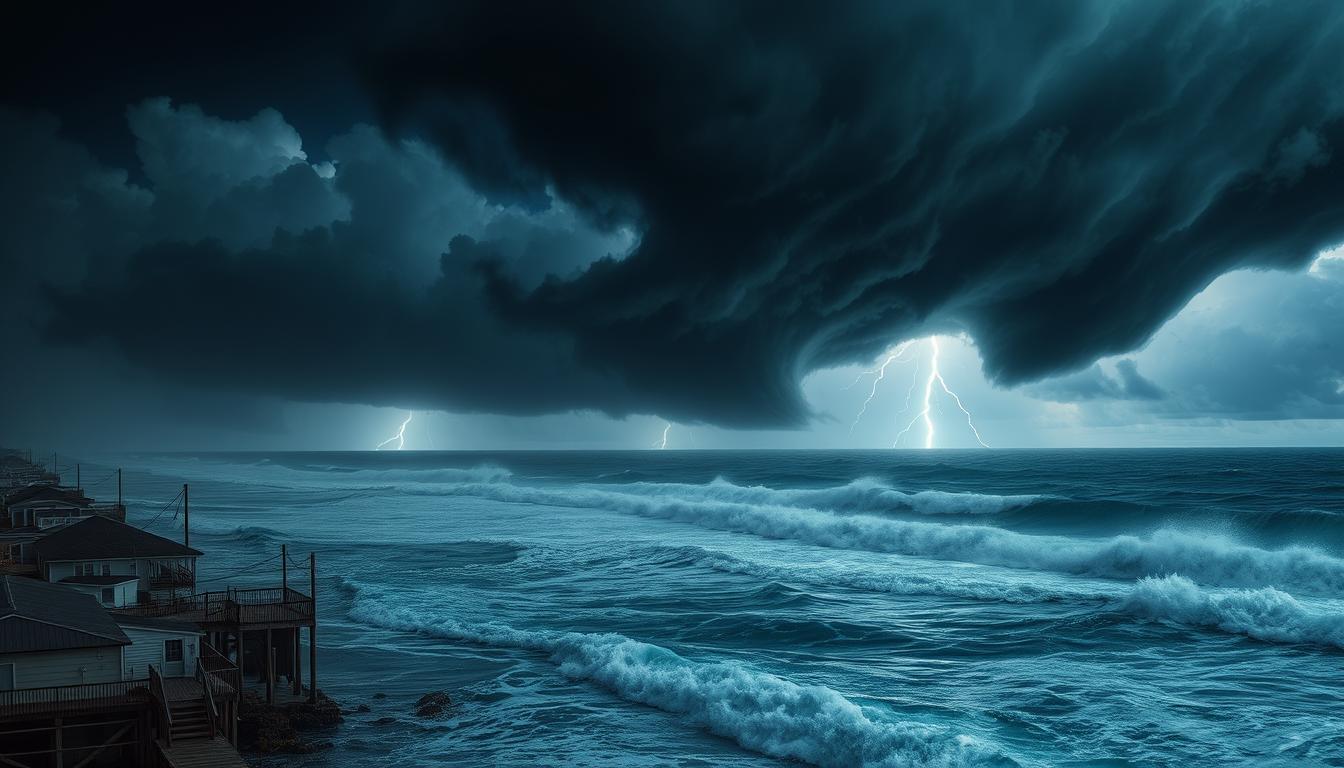As the 2024 hurricane season gets closer, are you ready for the storm? We now have better tools for tracking hurricanes and predicting their paths. But are you keeping up with the latest storm forecasts and emergency plans?
Key Takeaways:
- Stay informed with up-to-date12 hurricane forecasts and storm tracking data
- Understand the12 potential for life-threatening storm surge and flooding
- Heed evacuation orders and12 emergency preparedness guidelines
- Prepare your home and family for12 prolonged power outages and infrastructure disruptions
- Monitor2 severe weather alerts and1 tornado threats
Hurricane Helene: A Category 2 Storm on the Move
Latest Updates and Projected Path
As of the 8 a.m. advisory on September 26, 2024, Hurricane Helene was about 320 miles southwest of Tampa, Florida. It was moving north-northeast at 12 mph with winds of 100 mph1. Helene is expected to grow into a major Category 3 hurricane by afternoon, with winds up to 115 mph before hitting near Perry, Florida1.
Helene has been upgraded to a Category 2 storm and is expected to become a major hurricane soon3. The hurricane center warns of strong, damaging winds far inland across the southeastern U.S. Storm surges of up to 20 feet (6 meters) are forecasted in Florida’s Apalachee Bay3.
The storm is expected to be one of the largest to hit the region in years. Areas 100 miles (160 kilometers) north of the Georgia-Florida line will face hurricane conditions3. Helene could be the worst storm to hit a major Southern inland city in 35 years for Atlanta3.
Federal authorities have set up generators, food, water, search-and-rescue, and power teams in preparation3. Helene is the eighth named storm of the Atlantic hurricane season, predicted to be above-average due to warm ocean temperatures3.
As Hurricane Helene strengthens and moves northward, Gulf Coast residents must stay alert and prepared1. The storm’s wide reach and potential for catastrophic winds and storm surge make the next days critical for emergency management and community resilience3.
| Statistic | Value |
|---|---|
| Hurricane Helene’s Maximum Sustained Winds | 132 mph |
| People under Hurricane/Tropical Storm Warnings | Almost 80 million |
| Forecasted Storm Surge in Wakulla County, FL | Over 20 feet |
| Forecast Rainfall | Up to 18 inches |
“The Waffle House in Tallahassee, Florida, remained open with a ‘wait-and-see attitude’ as Hurricane Helene approached.”
Storm Surge and Flooding Risks
Hurricane Helene is heading towards the Florida coast, bringing a high risk of storm surge and flooding. Coastal areas in the Big Bend region could see up to 18 feet of storm surge. This is seen as “unsurvivable” by meteorologists2. Such flooding could flood homes, businesses, and important infrastructure, putting many lives at risk.
The danger isn’t just for coastal areas. Inland flooding is also a big worry as Helene moves through Georgia, the Carolinas, Tennessee, and Kentucky4. The warm Atlantic Ocean at the start of the season means more storms are expected in 20244. This makes it even more important to prepare for hurricanes.
It’s vital for people in Helene’s path to listen to warnings and follow local advice. Early evacuation and finding safe shelter could save lives.2 As the 2024 hurricane season goes on, staying alert, resilient, and planning ahead is key.
The 2024 season forecast includes chances of storms hitting different areas. Wind speed data is available for the North Atlantic4. Storm surge forecasts cover the U.S. Gulf and Atlantic coasts, Puerto Rico, and the U.S. Virgin Islands. Maps show where flooding is likely4. By staying informed and ready, communities can face this hurricane season better and reduce the harm from severe weather.
Evacuation Efforts and Emergency Preparedness
As Hurricane Helene heads towards Florida, local officials are telling people in the storm’s path to leave now5. 61 out of Florida’s 67 counties are under emergency due to the hurricane5. They stress the need to follow evacuation orders, even though it’s hard for some to leave5.
Heeding Warnings and Seeking Shelter
If you can’t leave, find shelter in an interior room on the lowest floor of a strong building, away from windows6. Tropical storm-force winds will hit South Florida by mid-morning Thursday6. Hurricane and tropical storm warnings cover almost the whole state, including Palm Beach, Broward, and Miami-Dade counties6.
The storm’s effects will also be felt in Georgia, with warnings in North Carolina6. People must listen to local authorities and be ready to act fast to keep themselves and their families safe1. Florida Governor Ron DeSantis says people in older homes should prepare for winds up to 120 to 125 mph1.
| Evacuation Challenges | Emergency Preparedness Measures |
|---|---|
|
|
“Residents must heed the warnings issued by local authorities and be prepared to take immediate action to protect themselves and their families.”
By working together and following emergency experts’ advice, we can get through this tough time and keep our communities safe1. The danger of storm surge is high along Florida’s Big Bend coast, with possible water levels up to 20 feet above ground1.
Widespread Impacts: Tropical Storm Warnings and Wind Gusts
As Hurricane Helene gets stronger, tropical storm warnings are now in effect for Palm Beach, Martin, St. Lucie, Indian River, and Okeechobee counties in Florida1. These warnings mean gusty winds and tropical storm-force wind gusts are coming. They could damage power lines, trees, and buildings1.
The latest news shows Hurricane Helene has grown to a Category 2 storm with winds up to 132 mph1. Also, almost 80 million people in Florida, Georgia, and Alabama are under hurricane and tropical storm warnings1.
In the target area, Wakulla County in Florida’s Big Bend region is expected to get over 20 feet of storm surge1. The hurricane will also bring maximum sustained winds of 100 mph, moving north-northeast at 12 mph1.
People in the affected areas should keep an eye on the hurricane tracker 2024 and storm tracking 2024 updates. This will help them stay informed and ready for the storm’s effects7.
“We’re now forecasting this to be one of the largest storms in the Gulf of Mexico in a century, spreading tropical rainfall and strong gusts over a large portion of the Peninsula by Thursday morning.”
As the situation changes, it’s key for residents to follow all tropical cyclone monitoring warnings. They should also take steps to keep themselves safe7.
Tornado Threats and Severe Weather Alerts
Hurricane Helene is heading towards the Florida coast. People in the area need to watch out for severe weather, like tornadoes8. Tornado warnings have been given for places like Naples and Cape Coral. This is because Helene’s outer bands might cause tornadoes8.
If you get a tornado warning, find a safe place right away.
Monitoring Rotating Thunderstorms
The National Weather Service is keeping a close eye on the storm8. They want everyone to get ready for tornadoes8. Most of Central Florida is under a tornado watch until 8 p.m. Thursday. There’s a chance of tornadoes in the rain bands8.
Tropical-storm-force winds could reach 345 miles from Helene’s center. This might cause gusts of up to 60 mph locally8.
It’s important to stay updated on severe weather alerts. By following the storm’s progress and listening to local warnings, you can keep your family safe. This way, you can prepare for the dangers that Hurricane Helene might bring.
“The safety of our community is our top priority. We urge everyone to closely follow the updates from the National Weather Service and be ready to take shelter if a tornado warning is issued for your area.”
– Local Emergency Management Coordinator
hurricane tracker 2024: Staying Up-to-Date with the Latest Information
As Hurricane Helene gets stronger and heads towards the United States, it’s key to stay informed and ready. Make sure to check weather forecasts, local news, and NOAA Weather Radio often. This will help you keep up with the hurricane’s path and any changes8.
It’s also smart to sign up for emergency alerts from local authorities. This way, you’ll get timely updates and instructions. It’s important to have the most accurate info to keep your family and property safe8.
- Monitor hurricane tracker 2024 and hurricane forecast 2024 for the latest updates on Helene’s movements and intensity.
- Stay tuned to local news and NOAA Weather Radio for the most up-to-the-minute storm tracking 2024 and tropical cyclone monitoring information.
By staying informed and ready, you can protect your family and property from this powerful hurricane. Remember, knowledge is power when facing a storm89.
“Forecasters warn of an ‘unsurvivable’ storm surge in northwestern Florida and potential vast inland damage across the southeastern US.”10
As Hurricane Helene gets closer, it’s vital to follow all warnings and instructions from local authorities. Stay safe, stay informed, and stay prepared for what’s coming810.
Impact on Infrastructure and Power Outages
Hurricane Helene is heading towards the U.S. coast, causing worry for power outages and damage to infrastructure7. It’s expected to be a Category 4 hurricane by Thursday, with winds of 130 mph7. The storm surge could reach 20 feet in Florida’s Big Bend coast7. This could be the fourth hurricane to hit the U.S. in 20247, leading to power outages for days or weeks7.
Emergency teams are preparing for the worst7. Over 50,000 people in western Cuba have lost power7. More than 800 flights are canceled for Thursday as the storm nears7. Florida is worried about power outages, with Tampa facing up to 8 feet of storm surge7.
Other states are also affected, with five declaring states of emergency7. McDowell County, North Carolina, is seeing flash flooding, leading to rescues7. Schools in Florida, Georgia, and more are closing early7. Helene is still a hurricane in Georgia on Friday, 150 miles from landfall7.
People in the storm’s path should take all warnings seriously. They should prepare for long power outages and have backup plans ready. Hurricane preparedness 2024 and emergency planning are key to dealing with this storm.7
“The threat of power outages in Georgia due to Helene is deemed significant and potentially unprecedented.”7
Aftermath and Recovery Efforts
As Hurricane Helene moves away, emergency teams quickly start to assess damage and plan for recovery11. Some areas had mandatory evacuations, and storm surges threatened up to 20 feet in the Big Bend and 5 feet in Charlotte Harbor11. The National Hurricane Center predicted Helene could reach Category 4 strength with winds up to 130 mph and gusts up to 160 mph11.
Assessing Damage and Providing Aid
Teams are now focused on search and rescue, removing debris, and restoring services11. Charities and volunteers will be key in helping the affected communities11. The federal government has set aside $172 million for flood victims, and Chicago has allocated $5 million to help seniors12.
People like Shirley Howard have received $4,400 to help with their recovery12. The Biden administration has also approved more FEMA funding for seven Illinois counties, including Cook County, hit by severe rain in July12.
The community is now focused on rebuilding and ensuring everyone has the resources they need to recover11
Historical Context and Lessons Learned
As we get ready for the 2024 hurricane season, it’s key to look back at past storms. Hurricanes like Helene can cause big problems, like coastal erosion and oil spills13. Climate change might make hurricanes more frequent and intense, so we need to act13.
Learning from storms like Katrina in 2005 and Harvey in 2017 is important. These lessons help us get better at preparing for and dealing with storms. For example, Katrina showed us the need for stronger buildings and better communication14. Harvey taught us to improve evacuation plans and strengthen key infrastructure.
As we face the 2024 hurricane season, staying alert and learning from the past is crucial. By keeping up with the latest14 hurricane news and14 how to prepare, we can be stronger. Together, we can lessen the effects of storms like Helene and create a safer future for our country.
















Leave a Reply